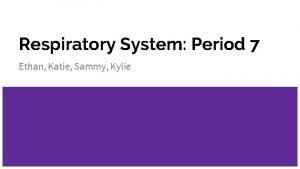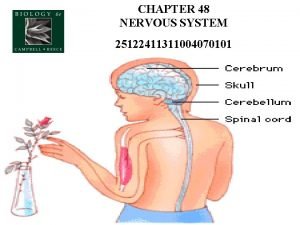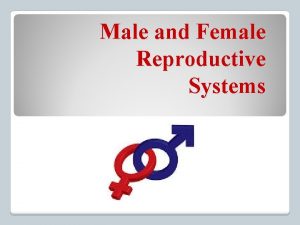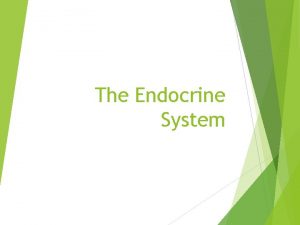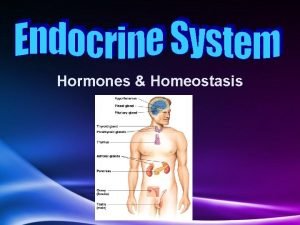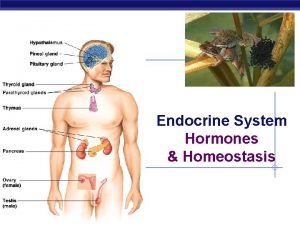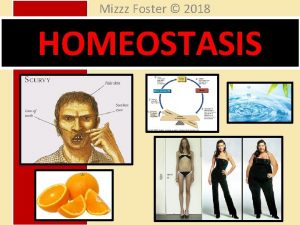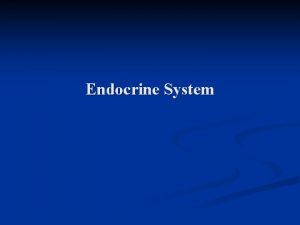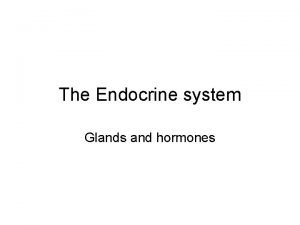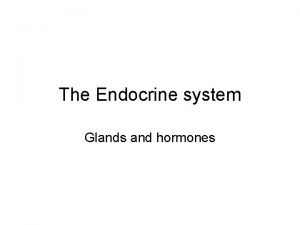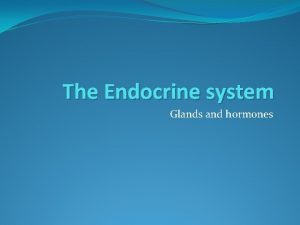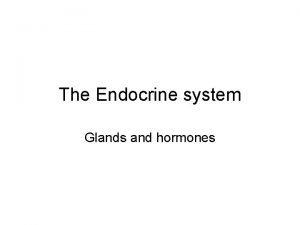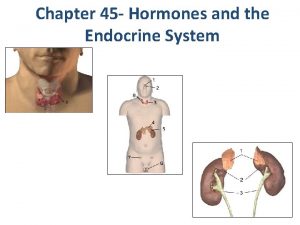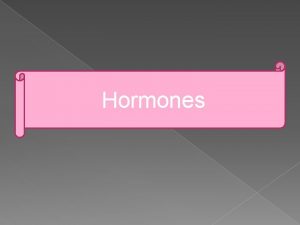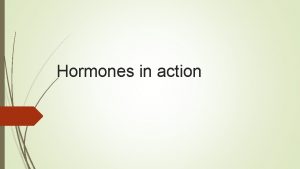Endocrine System Hormones and Homeostasis THE ENDOCRINE SYSTEM

















- Slides: 17

Endocrine System, Hormones, and Homeostasis

THE ENDOCRINE SYSTEM • Two body systems are responsible for sending and receiving sensory information and coordinating body responses. • These are the nervous system and the endocrine system. Together, they are sometimes referred to as the neuro-endocrine system. • The endocrine system regulates body activities by releasing hormones (chemical messengers) into the bloodstream, where they are carried throughout the entire body. • Hormonal responses may be almost instantaneous, or may occur days later. • There is a wide variety of hormonal effects.

EXOCRINE & ENDOCRINE GLANDS • The body contains two kinds of glands: • Exocrine glands secrete their products into body ducts, which carry the products into body cavities, the lumen of an organ, or the outer surface of the body. • Sudoriferous glands, sebaceous glands, mucous glands, and digestive glands. • Endocrine glands secrete their products (hormones) into the extracellular space around the secretory cells. The secretions diffuse into capillaries and are carried throughout the body by the circulatory system.

ENDOCRINE SYSTEM • The endocrine system is composed of the body’s endocrine glands. These include: • The pituitary, thyroid, parathyroid, adrenal, and pineal glands • There also many organs that have cells which secrete hormones, but are not exclusively endocrine organs. These include: • The hypothalamus, thymus, pancreas, ovaries, testes, kidneys, stomach, liver, small intestine, skin, heart, and placenta.


HORMONES • Hormones can have very powerful effects, even when present in very low concentrations. • There approximately 50 different hormones produced in the human body. Most of these only affect a few types of cells. • The specific cells which are affected by a hormone are called target cells. • Hormones influence their target cells by binding to proteins or glycoproteins in the cell membrane called receptors. Only the target cells for a certain hormone have receptors that will recognize and bind to that hormone.

HORMONES • Hormones that pass into the blood and act on distant target cells are called circulating hormones or endocrines. • Circulating hormones may linger in the blood for minutes to hours, exerting their effects for a prolonged period of time. • Eventually, circulating hormones are inactivated by the liver and excreted by the kidneys. • Hormones that act locally without first entering the bloodstream are called local hormones. • Local hormones that act on neighboring cells are called paracrines. • Local hormones that act on the same cell that secreted them are called autocrines. • Local hormones are usually inactivated very quickly.

I. Homeostasis A. The process of maintaining a stable internal environment (for the body) at a constant level or between narrow limits 1. Examples include blood p. H, oxygen and carbon dioxide concentrations, blood glucose, body temp, and water balance 2. By maintaining homeostasis all bodily functions can take place properly 3. All body enzymes work within the specific limits maintained by homeostasis (i. e. certain blood enzymes only work at a particular p. H) 4. Homeostasis involves monitoring levels of variables and correcting changes in levels by negative feedback mechanisms a. These negative feedback loops are most evident in the endocrine and nervous systems

B. One example of a nervous system feedback loop would be control of blood pressure

C. A hormonal example would be the control of water balance

II. Control of body temperature is another excellent example of homeostasis a. Body heat is created by metabolic activities in cells, esp. those of the liver, muscles, and brain b. During digestion and physical activity heat production is increased c. Shivering is the result of muscles contracting rapidly in order to create heat d. Heat is lost from an organism through conduction (transferring directly from skin to surrounding air) and evaporation (via sweat)

e. Heat is carried in the blood f. Areas where blood is close to the skin surface cool faster (which is why some people put their wrists under cold water or put a cold cloth on their neck and forehead) conserve g. Vasoconstriction helps the body to heat and vasodialation helps the body to lose heat h. The hypothalamus helps to regulate heat production and loss via feedback loops

3. Control of Blood Glucose Concentration a. Although other sugars exist in the blood, it is glucose that is most important and is monitored in order to maintain homeostasis b. Normally, blood glucose levels stay between 4 and 8 mmols/l c. Levels rise after meals and are usually lowest in the morning before breakfast d. If levels drop too low, hypoglycemia develops - symptoms include lethargy, impaired mental function and irritability


e. If levels are too high, hyperglycemia develops - symptoms include diabetes and its associated problems (eye, kidney, and nerve damage) f. Glucose levels are monitored by cells in the pancreas g. If blood glucose drops to a dangerous level, some of those cells (called alpha cells) produce glucagon, a hormone which activates liver cells to convert glycogen to glucose (glycogenolysis) and thus raise blood sugar

h. When levels of blood sugar rise (either due to a meal or as a result of glycogen conversion) insulin is released from the beta cells of the islet of langerhans (part of the pancreas) - insulin causes the liver to convert glucose to glycogen for storage i. Diabetes mellitus type I is caused by insufficient or non-existent production of insulin j. Diabetes mellitus type II is caused by a decreased response to insulin the tissues of the body

 Bioflix activity homeostasis low blood glucose
Bioflix activity homeostasis low blood glucose Bioflix activity homeostasis high blood glucose
Bioflix activity homeostasis high blood glucose Oxication
Oxication Nontropic hormones
Nontropic hormones Endocrine system and reproductive system
Endocrine system and reproductive system Endocrine system
Endocrine system Endocrine system and nervous system
Endocrine system and nervous system Lympathic
Lympathic Nervous system vs endocrine system venn diagram
Nervous system vs endocrine system venn diagram Differences between nervous system and endocrine
Differences between nervous system and endocrine Comparison of endocrine and nervous system
Comparison of endocrine and nervous system Endocrine and nervous system comparison
Endocrine and nervous system comparison How the respiratory system maintains homeostasis
How the respiratory system maintains homeostasis Nervous system homeostasis
Nervous system homeostasis Male and female hormones
Male and female hormones Male and female hormones
Male and female hormones Respond to
Respond to Plant hormones and responses
Plant hormones and responses












